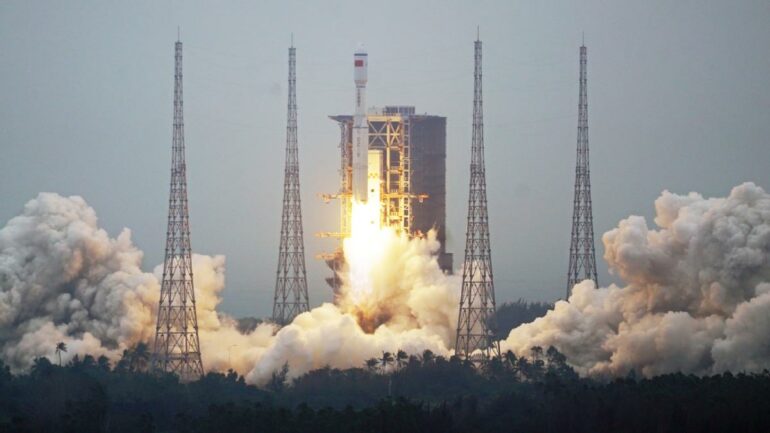China’s ambitious lunar exploration program is poised to take a significant stride forward with the imminent launch of the Queqiao-2 communications relay satellite. Scheduled for liftoff on March 19th, this critical satellite will play a pivotal role in maintaining communication links for China’s upcoming lunar missions, particularly the highly anticipated Chang’e-6 far-side sample return mission slated for May.
The Queqiao-2 satellite, weighing in at an impressive 1,200 kilograms and equipped with a 4.2-meter parabolic antenna, will be launched aboard China’s formidable Long March 8 rocket. Standing at an imposing 50.3 meters tall, the Long March 8 vehicle was vertically transferred to the launch pad at the Wenchang Satellite Launch Center on March 17th, setting the stage for the upcoming liftoff.
Once in space, the Queqiao-2 satellite will assume a highly elliptical lunar orbit, strategically positioning itself to facilitate communication between Earth and the far side of the Moon. Utilizing X and UHF bands, the satellite will serve as a vital communications relay, enabling seamless data transmission and command execution for China’s ambitious Chang’e spacecraft.
With an expected lifetime of nearly a decade, the Queqiao-2 satellite is poised to play a crucial role in supporting not only the Chang’e-6 mission but also the subsequent Chang’e-7 and Chang’e-8 missions, which aim to explore the lunar south pole region.
While China’s space administration has yet to release official launch times, airspace closure notices have provided insights into the launch window. According to reports from SpaceNews, airspace closures are scheduled between 8:21–8:47 pm and 9:45–10:16 pm ET on March 19th, indicating the potential launch timeframe.
This launch will mark the third flight of China’s Long March 8 rocket, a vehicle that made its debut in 2020 and set a national record in 2022 for the most satellites launched by a single rocket – a record that was later surpassed by a Long March 2D rocket in 2023.
The Chang’e-6 mission, which will benefit from the Queqiao-2 satellite’s support, aims to retrieve approximately 2,000 grams of lunar regolith from the far side of the Moon, building upon the success of the Chang’e-5 mission in 2020, which returned 1,731 grams of lunar samples from the near side.
In addition to its primary communication relay duties, the Queqiao-2 satellite will also carry scientific payloads, including an extreme ultraviolet camera and an Earth-moon length baseline very long baseline interferometry (VLBI) experiment, further expanding the scientific capabilities of China’s lunar exploration program.
The launch will also see the deployment of two small experimental satellites, Tiandu-1 and Tiandu-2, which will fly in formation in lunar orbit, conducting navigation and communication tests, including satellite-to-ground laser ranging and inter-satellite microwave ranging methods.
As China continues to push the boundaries of lunar exploration, the successful launch and deployment of the Queqiao-2 satellite will mark a significant milestone, paving the way for future missions and solidifying the country’s position as a formidable player in the ongoing quest to unravel the mysteries of Earth’s nearest celestial neighbor.

